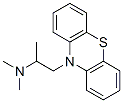
Promethazine
Name: Promethazine
Synonyms: 10-(2-Dimethylamino-1-propyl)phenothiazine
Molecular Structure:
 Molecular Formula: C17H20N2S
Molecular Weight: 284.42
CAS Number: 60-87-7
EINECS: 200-489-2
Promethazine is a first-generation H1 receptor antagonist, antihistamine and antiemetic medication. Promethazine can also have strong sedative effects and in some countries is prescribed for insomnia when benzodiazepines are contraindicated. Promethazine is a prescription drug in the United States but is available over the counter in the United Kingdom, Canada, Switzerland, Australia, and many other countries (brand names Phenergan, Promethegan, Romergan, Fargan, Farganesse, Prothiazine, Avomine, Atosil, Receptozine, Lergigan).
Chemically, promethazine hydrochloride (HCl) appears as a white to faint yellow crystaline powder that is practically odorless. Slow oxidation may occur upon prolonged exposure to air usually causing blue discoloration. Promethazine as the hydrochloride salt is freely soluble in water and somewhat soluble in alcohol. Promethazine is a chiral compound, occurring as a mixture of enantiomers (pictured).
Promethazine is a phenothiazine derivative that competitively blocks histamine H1 receptors without blocking the secretion of histamine. Promethazine also is a very weak dopamine antagonist (blocker). Promethazine has sedative, anti-motion-sickness, anti-emetic, and anti-cholinergic effects |